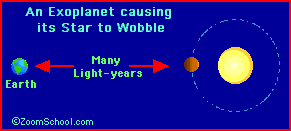Recently, other stars with orbiting planets have been discovered. These planets have not been seen, but have been detected by the very slight 'wobble' they induce in their star.
 Recently, many planets orbiting stars other than our sun have been discovered. These planets (called exoplanets) have not yet been directly seen by us, but they have been detected by the very slight “wobble” they induce in their star.
Recently, many planets orbiting stars other than our sun have been discovered. These planets (called exoplanets) have not yet been directly seen by us, but they have been detected by the very slight “wobble” they induce in their star.
Stars with orbiting planets “wobble” slightly as their planets gravitationally tug at them. By observing and measuring the amount of “wobble” over time, astronomers can calculate how massive a planet (or planets) would have to be make that star “wobble” that much.
Using this method, large planets are more easily detected than smaller ones. Also, planets in closer (faster) orbits are more easily found. Thousands of exoplanets have been found so far, including gas giants (mostly hydrogen and helium, like Jupiter), water-dominated planets, and rocky ones (like Earth and Mars).
Upsilon Andromedae
A Star with Recently-Discovered Orbiting Planets
| Planet | Distance from υ Andromedae (Astronomical Units) |
Orbital Period (Planetary Year) |
Mass of the Planet |
|---|---|---|---|
| b (Saffar) | 0.06 AU | 4.6 Earth days | ~1.70 times the mass of Jupiter |
| c (Sahm) | 0.83 AU | 242 Earth days | ~13.98 times the mass of Jupiter |
| d (Majriti) | 2.53 AU | 3.5-4 Earth years | ~10.25 times the mass of Jupiter |
| e | ~5.25 AU | ~10.5 Earth years | ~1.06 times the mass of Jupiter |
Upsilon Andromedae is a star in the constellation Andromeda. Astronomers Geoffrey W. Marcy and R. Paul Butler discovered a massive planet orbiting this star (with each orbit taking only 4.6 days) in 1996. Recently, 3 other planets have been discovered orbiting this star. The first three planets orbit within 2.5 astronomical units of the star, while the last one is much further away at 5.25 AU.
Web Links about other Solar Systems
Exoplanet Data Explorer an interactive table and plotter for exploring and displaying data from the Exoplanet Orbit Data (no longer updated as of 2018).
